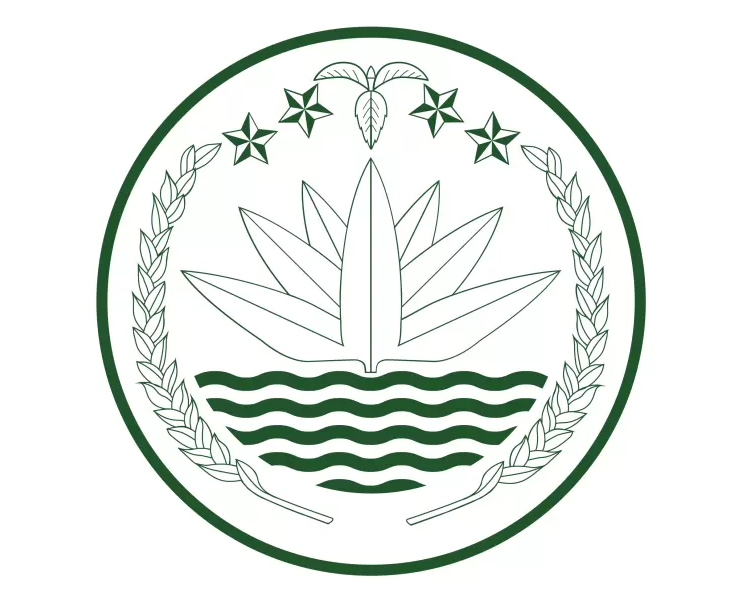The Bangladesh National Emblem is an important symbol of the country's identity, culture, and history. It represents the ideals of the nation and its people, and has a long and interesting history. In this article, we will explore the design, symbolism, legal significance, and controversies surrounding the Bangladesh national emblem.
The national emblem of Bangladesh was adopted in 1971, after the country gained independence from Pakistan. It was designed by a group of artists and intellectuals, led by the famous artist Zainul Abedin. The emblem consists of a stylized lotus, surrounded by four stars and three connected jute leaves, all within a circle.
The emblem is an important symbol of Bangladesh's identity and culture, and is used in official documents, government seals, and national monuments. It is also a source of pride for the people of Bangladesh, and is often displayed in public spaces and private homes.
Design and Symbolism of the Bangladesh National Emblem
The center emblem of the Bangladesh national emblem is a stylized lotus, which represents purity, integrity, and beauty. The lotus is a common symbol in many cultures, and is often associated with spiritual and religious significance.
The four stars surrounding the lotus represent the four founding principles of Bangladesh: nationalism, secularism, socialism, and democracy. These principles were enshrined in the country's constitution in 1972, and continue to be important values for the people of Bangladesh.
The three connected jute leaves at the base of the emblem represent the country's main cash crop, jute. Jute has played an important role in the country's economy and history, and is still a major export for Bangladesh.
Together, the elements of the national emblem represent the ideals and values of Bangladesh, as well as its rich cultural heritage and natural resources.
Evolution of the Bangladesh National Emblem
The first national emblem of Bangladesh was adopted in 1971, when the country gained independence from Pakistan. It featured a map of Bangladesh, with a rising sun and a water lily in the foreground. However, this emblem was not widely accepted by the public, and a new design was commissioned in 1972.
The current national emblem was designed by a group of artists and intellectuals, led by Zainul Abedin. It was adopted on January 26, 1972, and has remained unchanged since then.
Legal Significance of Bangladesh National Emblem
The national emblem of Bangladesh is protected under the law, and its use is regulated by the government. It is used in official documents, government seals, and national monuments, and is also a trademark of the government of Bangladesh.
Any unauthorized use or alteration of the national emblem is strictly prohibited and may result in legal action. The emblem is also featured prominently on the country's passport, currency, and official flags.
Controversies Surrounding the Bangladesh National Emblem
Despite its widespread use and significance, the national emblem of Bangladesh has also been the subject of controversy and criticism. Some have argued that the emblem's design is outdated and does not accurately represent the country's current identity or values.
Others have criticized the political use of the emblem, particularly during times of political unrest or conflict. For example, during the 2007-2008 Bangladeshi political crisis, the emblem was used by both the government and opposition forces as a symbol of their respective positions.
FAQs
- What is the significance of the four stars in the national emblem?
The four stars represent the founding principles of Bangladesh: nationalism, secularism, socialism, and democracy.
- What is the meaning of the three connected jute leaves in the emblem?
The jute leaves represent the country's main cash crop, and symbolize its economic and agricultural heritage.
- Is the national emblem used in the country's flag?
No, the national emblem is not featured on the Bangladesh flag, but rather on other official documents and symbols.
- How has the emblem evolved over time?
The national emblem has gone through several iterations since the country's independence, but the current design has remained unchanged since 1972.
- Has there been any controversy surrounding the national emblem?
Yes, there have been criticisms of the emblem's design and political use, particularly during times of political unrest or conflict. However, it remains an important symbol of Bangladesh's identity and culture.
Conclusion
The national emblem of Bangladesh is an important symbol of the country's identity and values. Its design and symbolism reflect the ideals of the nation and its people, and its legal significance is recognized and protected under the law. While there have been controversies and criticisms surrounding the emblem over the years, it remains a source of pride and identity for the people of Bangladesh.
References
- "The National Emblem of Bangladesh." Bangladesh Government, http://www.bangladesh.gov.bd/index.php?option=com_content&task=view&id=694&Itemid=564.
- Rahman, Syedur. Historical Dictionary of Bangladesh. Scarecrow Press, 2010.
- Karim, Afsan Chowdhury. "The National Emblem of Bangladesh: The Story Behind the Logo." The Daily Star, 3 June 2017, https://www.thedailystar.net/opinion/heritage/the-national-emblem-bangladesh-the-story-behind-the-logo-1411577.
